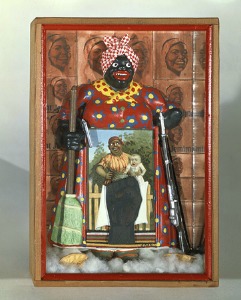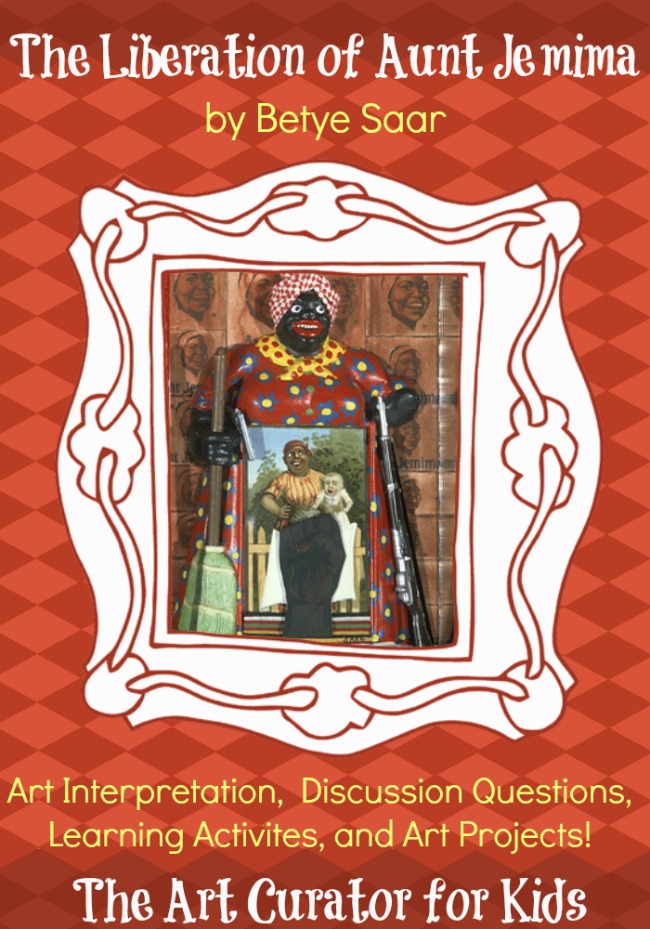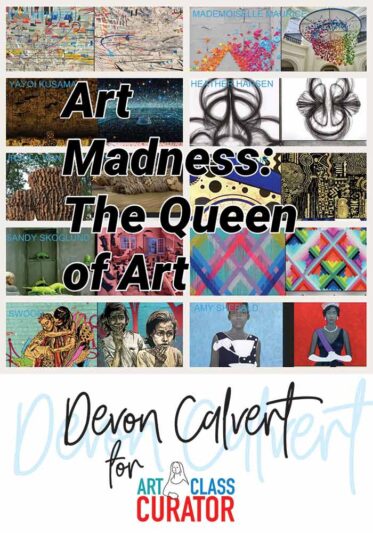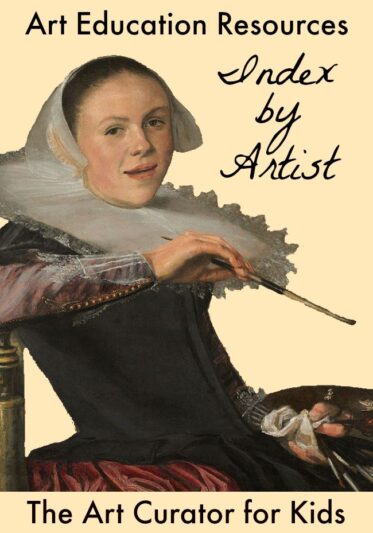Today’s artwork is The Liberation of Aunt Jemima by Betye Saar.
Exploring Tough Topics through Art
This artist uses stereotypical and potentially-offensive material to make social commentary. I feel it is important not to shy away from these sorts of topics with kids. We can’t sugar coat everything and pretend these things don’t exist if we want things to change in our world. We need to have these hard conversations and get kids thinking about the world and how images play a part in shaping who we are and how we think. Art is an excellent way to teach kids about the world, about acceptance, and about empathy.
Betye Saar’s The Liberation of Aunt Jemima

This artwork is an assemblage which is a three-dimensional sculpture made from found objects and/or mixed media. It’s essentially like a 3d version of a collage.
In the artwork, Saar included a knick-knack she found of Aunt Jemina. It was Aunt Jemima with a broom in one hand and a pencil in the other with a notepad on her stomach. Instead of the pencil, she placed a gun, and in the other hand, she had Aunt Jemima hold a hand grenade. In the spot for the paper, she placed a postcard of a stereotypical “mammy” holding a biracial baby. The mammy’s skirt is made up of a black fist, a black power symbol. She put this assemblage into a box and plastered the background with Aunt Jemima product labels.
Art Discussion Questions
Okay, now that you have seen the artwork with the description, think about the artwork using these questions as a guide. Or, use these questions to lead a discussion about the artwork with your students.
- What was your first reaction to seeing this image?
- What do these images remind you of?
- Describe the women in this image. What is wrong about how they are portrayed?
- What is the artist trying to say by putting these objects and images together? What is her message?
- Saar called this her first protest piece. What is she protesting?
- Why do you think the artist included the gun and hand grenade? Do you think they symbolize violence or something else?
Interpretation of Betye Saar’s The Liberation of Aunt Jemima
Saar’s goal in using these controversial and racist images was to reclaim them and turn them into positive symbols of empowerment. Instead of me telling you about the artwork, let’s hear it from the artist herself!
Watch this video of Betye Saar discussing The Liberation of Aunt Jemima:
Isn’t it so great we have the opportunity to hear from the artist?
Related Art Learning Activities
Use these activities to further explore this artwork with your students.
Stereotypes Art Project:
Students can make a mixed-media collage or assemblage that combats stereotypes of today. It’s easy to see the stereotypes and inappropriateness of the images of the past, but today these things are a little more subtle since we are immersed in images day in and day out. Have students look through magazines and contemporary media searching for how we stereotype people today through images (things to look for: weight, sexuality, race, gender, etc.). Then, have students take those images and change and reclaim them as Saar did with Aunt Jemima.
Research and Writing Activity:
Have students study stereotypical images of African Americans from the late 1800s and early 1900s and write a paper about them. They also could compare the images from the past with how we depict people today (see art project above).
Study More Artists:
Have students study other artists who appropriated these same stereotypes into their art like Michael Ray Charles and Kara Walker. Students can look at them together and compare and contrast how the images were used to make a statement. Note: I would not study Kara Walker with kids younger than high school. There are some disturbing images in her work that the younger kids may not be ready to look at.
This post was originally published on February 15, 2015.






Love this website! Thank you. mj
You’re welcome, and thank you! 🙂
Beautiful post! I can not wait to further this discussion with my students
Thank you! Let me know how it goes. 🙂
This post intrigues me, stirring thoughts and possibilities. I know that my high school daughters will understand both the initial art and the ideas behind the stereotypes art project. I’m not sure about my 9 year old. Would a 9 year old have the historical grasp to understand this particular discussion? What do you think?
You know, I think you could discuss this with a 9 year old. I think stereotypes are everywhere, so approaching it in a more tangible “what is it like today?” way may help. Also, you can talk about feelings with them too as a way to start the discussion–how does it make you feel when someone thinks you are some way just because of how you look or who you are? (Sorry for the slow response, I am recovering from a surgery on Tuesday!)
Thank you for sharing this it is a great conversation piece that has may levels of meaning. As a child of the late 70’s I grew up with the syrup as a commonly housed house hold produce. As a young child I sat at the breakfast table and I ate my pancakes and would starred at the bottle in the shape of this women Aunt Jemima. I would imagine her story. It was clear to me that she was a women of servitude. I imagined her in the kitchen facing the stove making pancakes stirring the batter with a big wooden spoon when the white children of the house run into the kitchen acting all wild and playing tag and hiding behind her skirt. Aunt Jemima whips with around a sharp look and with the spoon in a hand shaking it at the children and says, “Go on, get take that play somewhere else, I ain’t ya Mammy!” The children immediately stop in their tracks look up at her giggle and begin chanting I ain’t ya Mammy as they exit the kitchen. They can be heard throughout the house singing these words which when run together in a chant sung by little voices sound like into Aunt Jemima. As a loving enduring name the family refers to their servant women as Aunt Jemima for the remainder of her days.
For me this was my way of writing a story that gave this servant women a place of dignity in a situation that was beyond her control. She was the one who ran the house, the children had respect for her, she was an authority figure. The mother of the house could not control her children and relied on Aunt Jemima to keep her home and affairs in order. The origination of this name Aunt Jemima from I ain’t ya Mammy gives this servant women a space to power and self worth.
Thanks so much for your thoughts on this! I love it. I hope future people reading this post scroll to the bottom to read your comment. 🙂
this is really good. yes im a kid but, like, i love the art.
Thank you Nathan!